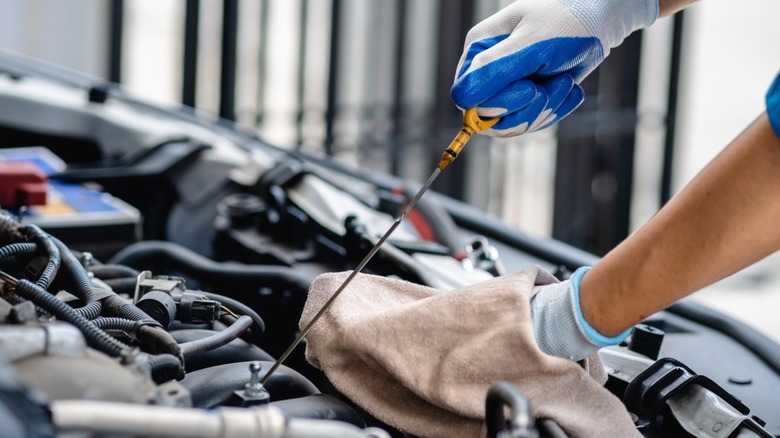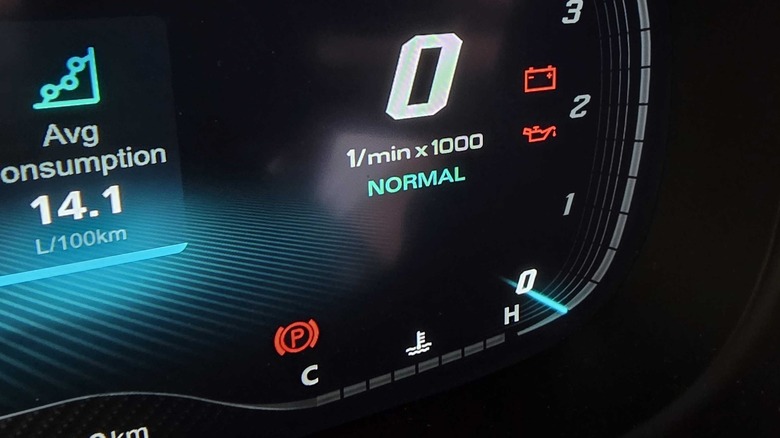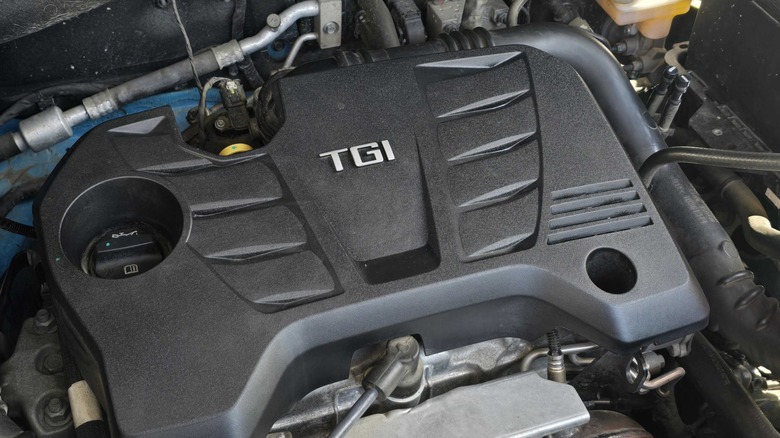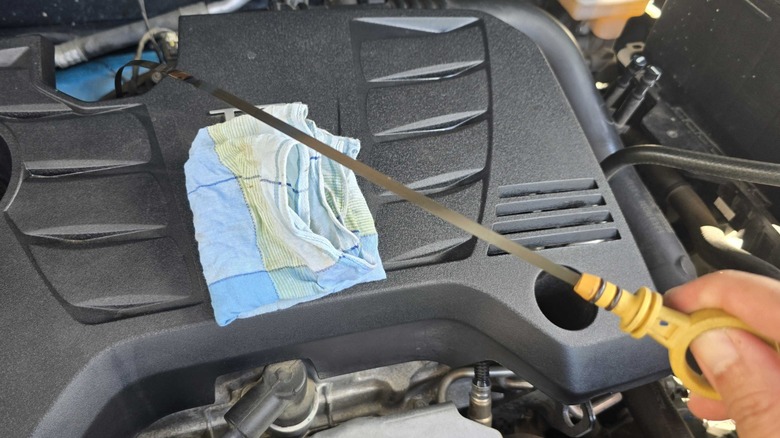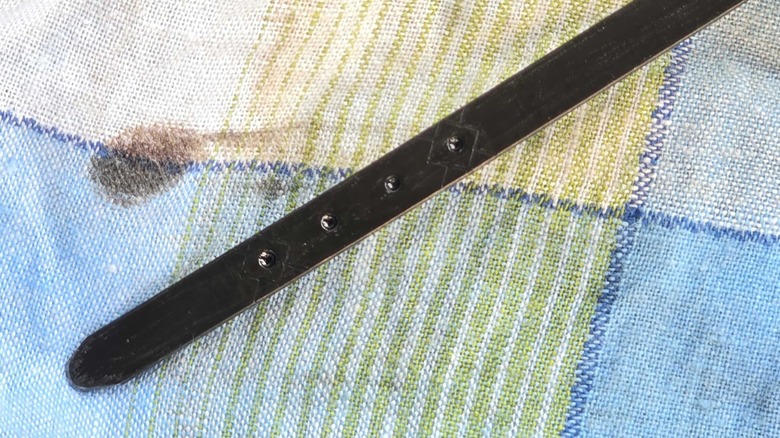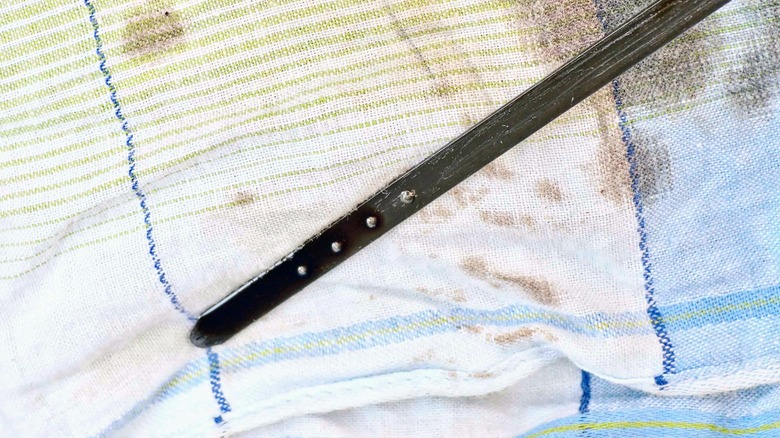How To Read Your Car's Oil Level On A Dipstick
Engine oil is crucial to keep your car running smoothly, and while your engine isn't supposed to consume oil like it uses up fuel, you still tend to lose some of it as you use your vehicle daily. So, to ensure that you're not running out of this important lubricating fluid, you must check your car's engine oil level occasionally. Checking the oil level of your car is also one of the first things you should do if you're looking for the reason why your low engine oil pressure warning light turns on on your instrument panel.
Unfortunately, unlike the fuel tank, most cars do not have an oil gauge inside the cabin. Instead, you have to go to the engine bay and find the oil level dipstick in your car to check how much engine you have left. So, if you haven't done that before, here's a step-by-step guide on how to read your car's engine oil level and find out if you still have enough oil to keep it running or if it's time to change the oil in your car.
Make sure your car's turned off and cool
When you're checking your car's engine oil, you have to ensure that it's turned off and cool. The primary reason for this is that engines are hot and dangerous when they're running, and you don't want to get caught or burned in the engine bay when getting to the dip stick. Furthermore, a running engine will have oil circulating throughout it, meaning you will not get an accurate reading of the amount of engine oil in the oil pan.
Another thing that many forget but is crucial for getting the correct oil level reading is to park your car on level ground. Parking on an incline means that the oil can pool on either side of your engine oil pan, which could lead to an inaccurate oil reading. While too little oil is bad, overfilling your engine with oil could also cause some damage, like excessive engine oil pressure leading to oil leaks or your engine burning oil alongside fuel in the combustion chamber.
Find your engine oil dipstick
When your car is turned off and the engine has cooled down somewhat, it's time to look for the engine oil dipstick. This dipstick is a long, thin metal strip with some markings at the end to show your car's oil levels. Note that some engines might have multiple dipsticks, so the first one that you see might not be the correct one for your engine oil. Depending on your car model, it might also have transmission and power steering fluids that need occasional top ups.
Engine oil dipsticks are often attached to a yellow handle in your engine bay, with some manufacturers adding an oil logo to make it easier to find. If you can't find your engine oil dipstick at first glance or if you're unsure if you're holding the correct dipstick, you can always refer to your car's manual. This will show where the dipstick is located and tell you how much oil you should have left to safely use your car.
Have a rag ready to wipe it clean
Before pulling your dipstick, always have a rag ready to clean the area around the dipstick area and the dipstick itself. Car engine bays are often dusty and dirty, so you want to ensure that nothing contaminates your engine oil while you're reading it. It's wise to clean up the area around the dipstick before pulling it out. If you have the time, a quick wipe of your engine cover would also help keep your working area clean and prevent dust from getting on your hands.
After doing that, you can pull out the dipstick, but what you see is often not the correct oil reading. Since the dipstick lives inside the engine, oil can splash and travel up the stick when you're driving. To ensure you're getting an accurate report of your oil levels, you should wipe the dipstick clean after pulling it out the first time, fully stick it back in, and then pull it out again. After you do that, you should see the actual amount of oil remaining in your engine's oil pan.
Checking your car's oil level
Markings on engine dipsticks vary. Some label two spots as "full" and "low, while others have three or four unlabeled markings, which tell you how much oil is left in your engine. The oil level in your engine should always fall between the first and last markings to ensure that you have a safe amount of oil.
If the oil level falls near or below the lowest marking, then you have too little oil in your engine and should refill it with the correct engine oil classification. If the dipstick shows a reading somewhere in the middle, you can still choose to top the oil off. On the other hand, if the oil level is above the highest mark, your engine is overfilled with oil, so you should drain it a bit to prevent engine problems.
It's wise to consistently check your car's engine oil levels once a month, especially if it's getting old, and you should definitely check its level before embarking on a long road trip. That way, you can catch any issues before they become bigger problems and avoid getting stuck on the road.
Don't forget to look at the color and viscosity of your oil
Aside from checking your engine oil levels, you should also look at the color and viscosity of your engine oil to see if it's still good enough to use or if you need to change it. Besides that, the color of your engine oil can tell you a lot of things. Fresh engine oil should be amber or yellow in color and look like freshly melted butter; it should also flow a bit and look like it's easy to pour. If your engine oil looks more orange or light brown, it signifies that it's already been used for a few miles but should still be good to go for a few more. However, you should consider scheduling your next oil change already in a few months' time.
If your engine oil is dark brown or black, like the photo of the engine oil in my car above, you should change it as soon as possible. Since I last had my oil changed almost six months ago, it's about time to change it. Oil darkens over time as it gets soot, carbon, and other dirt from your engine, which also makes it more viscous, making it less effective in lubricating your engine. That's why it's crucial to stick to your oil change schedule as described by your manual to keep your car in tip-top shape.
